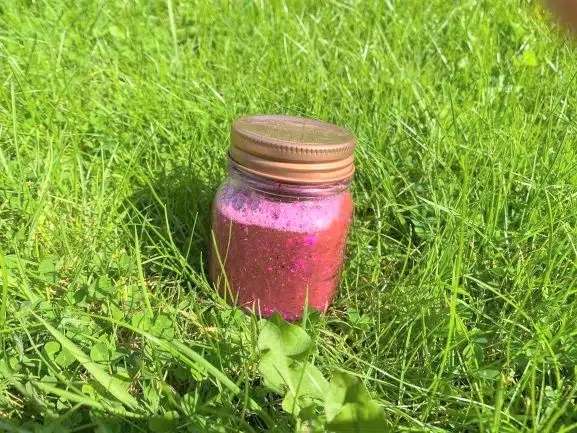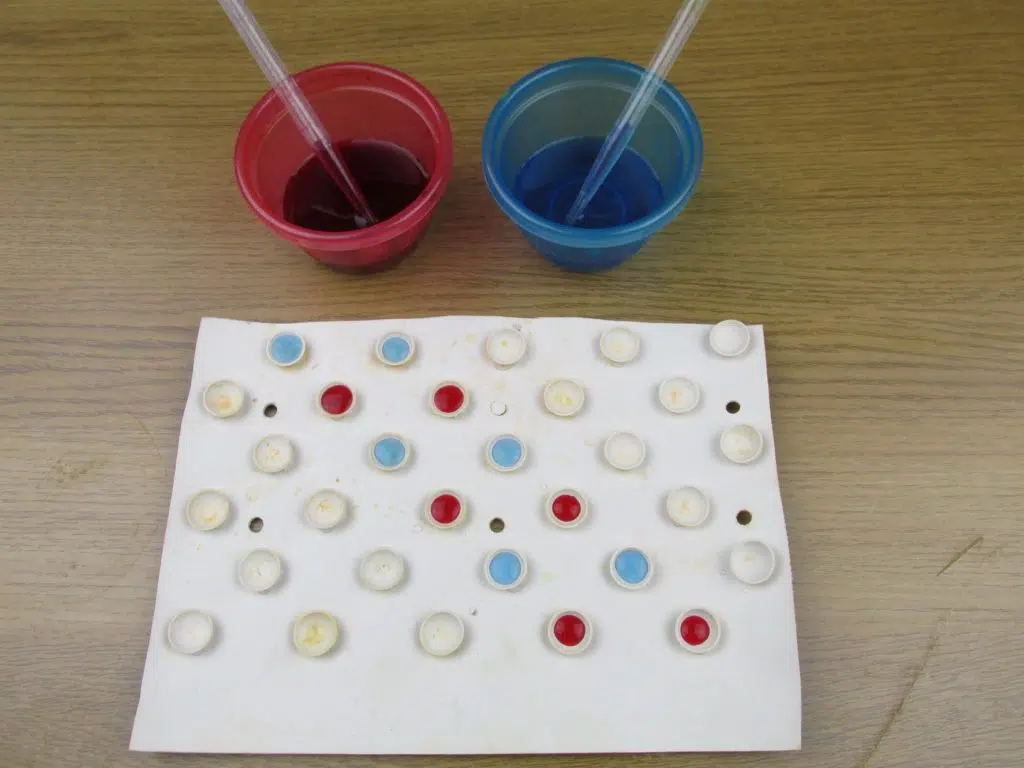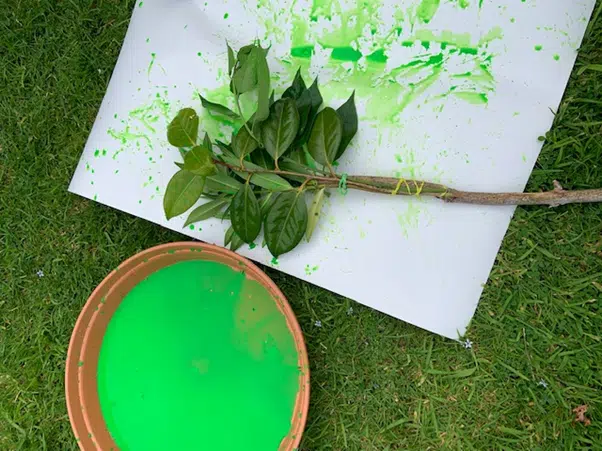You may have noticed that some children will spend hours pouring water onto the mud and giving it a good stir!
Or they will love watching the snow melt, crunching it up until all that’s left is water.
Well, there’s a reason for these behaviors…they are a transformation schema in action.
A transformation schema is an interest in things changing in substance or appearance. Children who show this schema will have a fascination for objects and themselves changing in some way. (Source)
In this post, I’ll take a look at exactly what is going on with transformation schemas, why we would want to support them, and then take a look at lots of activities that really help children who show this kind of schematic play.

What Is A Schema?
A schema is a repeated pattern of behavior. They are a way for children to test out on reality the models they have created in their minds.
The theory of schemas has developed over the last 100 years since the 1920s.
Schemas help children express their thoughts and ideas. They also provide clues as to how they learn, and how they view the world.
For example, a child that enjoys stirring puddles with a spoon, watching windmills, and winding wool around sticks, may well be demonstrating a rotation schema.
Likewise, a child that shows an interest in moving objects around your classroom, carrying them in buckets, filling up their pockets with items, and wheeling objects around on a trailer, is probably demonstrating a transporting schema.
There are arguably up to about 37 schemas, (Source) but most common are the nine that are discussed most in child development circles.
These common nine schemas are:
Transporting
Connecting
Transformation
Enveloping
Enclosing
Rotation
Orientation
Trajectory
Positioning
What Is A Transformation Schema?
A child with a transformation schema will be interested in objects or people changing in some way.
These children are interested in cause and effect.
They are always asking the question, ‘What if?’
A transformation schema will manifest itself in all sorts of ways. You may observe some of the following:
- A fascination for mixing objects and substances
- Pouring water on lots of different things!
- Covering objects or themselves in substances or paint
- Enjoying making potions, and concoctions in various contexts
Why Should We Support Schemas?
The reason that we want to understand and observe schemas, is that we can then use them for many positive ends.
By identifying and then supporting schema play, you tap into children’s interests and instincts. You are working with nature and the child for the best results.
Schemas help deepen and intensify play experiences.
They help children learn more coherently, and more completely.
They also help children think, flourish, and make good progress.
26 Activities To Support Transformation Schemas
Here is a selection of simple activities that support transformation schemas.
There is a mixture here of resources that can be provided for child-led play, and activities that can be suggested by an adult.
1. Gloop/Slime
Lots of children love this, but it is especially fantastic for children with a transformation schema!
The simplest way to make it is with some cornflour and just a little water. You can also add a few drops of paint powder or natural food coloring if you want to make it colored slime.
Of course, the classic color for slime is green!
Children love to prod, poke, and manipulate it in all sorts of ways.
The slime is continually transforming from runny to hard and is a fascinating substance to explore physically.
I’ve heard this type of gloop or slime is also sometimes known as oobleck after the Dr. Seuss book about a slime of that name.
2. Hapa Zome – Bashing Flowers With Hammers
This is a beautiful Japanese form of art.
You need something like a log slice, a piece of white cloth, some flower petals, a hammer, and some goggles.
Children place the flower petals on the log slice and cover them with the cloth. They then hit the cloth repeatedly with the hammer.
This bashes up the petals which dye the cloth.
I would supervise this activity one-to-one if you do it with younger children.

3. Ice And Snow
On snowy days, filling up a big play tray indoors with snow will attract many children with a transformation schema.
Throughout the day the snow will go through several phases – fluffy, then mushy, and finally watery.
This process is the same outdoors on a much grander scale.
Ice and snow will be continually changing, especially when you:
- Walk through the snow making footprints
- Watch icicles dripping
- See how freshly fallen snow changes over the coming days
- See how trees and bushes look in different levels of snowfall
4. Puddle Art
Puddles are a great source of fascination for many children, and there are several ways you can use them to support a transformation schema.
- Children can swirl paint in them from brushes
- They can add leaves and natural objects to the puddles to make potions
- They can sweep them, and reduce the size of the puddle, or divert its flow
5. Making Potions
This is one of the ultimate activities of childhood and can be either spontaneous or adult-led.
Making potions can be as simple as putting leaves in mud and mixing them with a stick.
Or it could be as complex as following a recipe and adding loose parts to a pan, using cooking utensils, and a range of ingredients.
Children with a transformation schema enjoy watching the change in the appearance of objects and substances as they mix together.
6. Making Smoothies
These could be ‘real’ smoothies that you drink, for example, made of fruit blended together.
Or you can make disgusting monster smoothies from mud, water, and whatever else you’d like to add to them.
7. Making Playdough
Children get a lot out of the actual process of experiencing homemade playdough being created.
Get them to measure quantities and mix materials.
They can observe the healing process, either in a pan or a microwave, where the liquid dough hardens to form a squidgy solid.
8. Creating Glitter Jars
This is a beautiful mindfulness activity.
For this, you need a simple glass or plastic jar with a lid, some water, and some glitter (or an eco-friendly replacement if you prefer).
Pour water into the jar, and pour in a few teaspoons of glitter. You can also add some glitter glue to add to the oily effect of the water.
Secure the lid.
These jars can then be shaken. Children can watch as the
A note on disposing of glitter. Glitter should never be washed down the sink, as it causes damage to river ecosystems. Ideally, sieve out the glitter, and dispose of it in the garbage.

9. Hand/Foot Painting
A common behavior among children who display a transformational schema is the desire to paint their hands or feet.
They enjoy the process more than any finished work of art that they create.
Foot painting can be done outdoors on a large wallpaper on a dry day.
10. Face Painting
Ever noticed that some children love face paint, and some hate it?
Perhaps transformation schemas are partly at play here.
Children with this type of schema will be interested in how themselves and others can morph into different characters and animals.
Face painting is best done adult-led, with the adult administering the face paint.
11. Any Recipe
Any cooking or recipe activity will have lots of transformation as part of its process.
Foods merge, change texture, and their properties change.
12. Mixing Colors
There are so many different ways of mixing colors!
Mixing colors activities are great for generating talk, excitement, and curiosity, as well as supporting transformation schemas.
One of my favorite mixing colors activities is using pipettes to squirt paint onto different substances.
The paint you use is watered down – I use little pots of water with a bit of paint stirred in.
Squirt the paint onto big surfaces like wallpaper to make Jackson Pollock style art.
Or you can use a bath mat, that will look a bit like this:

Squirt the paint into the suction pads. You can mix colors as you go.
Other ways of mixing colors include:
- Creating potions with water with different food colorings in it
- Hand painting
- Printing with paint (for example using potatoes)
Incidentally, if you liked the pipette idea, then here is my article about 16 amazing pipettes activities that you can try.
13. Drawing On Face/Body
Many children will try to draw on their faces or bodies.
Admittedly, this is not something you really want to be supporting most of the time!
However, it’s good to know their motivation.
They may use:
- Mud
- Pens
- Paint
- Water
14. Dress Up Clothes
This is a classic transformational schema activity!
Children enjoy putting on a range of clothes and transforming into different characters!
They can be:
- Characters from stories
- Their friends
- Change their age
- Change their voice
- Animals
Often just one piece of clothing will do the trick. Put on a hat, and away you go.
Or some of the following:
- A bag
- Shoes
- Coats
- Dresses
- Character clothing
The list will be pretty much endless.
15. Playdough
When it’s created, playdough itself also offers many transformational schema opportunities.
You can add small objects to it, such as beads or sequins.
It can be bent, cut, molded, and rolled into new shapes.
To read my favorite playdough math activities, then check this post out.
16. Wellington Boot Stamping In Mud
This is a really enjoyable way of manipulating a transformational substance – mud.
Children can watch the way their boot patterns become imprinted.
They see the mud oozing, squelching, and changing its shape.
17. Natural Paintbrushes With Mud
There are many simple ways to make natural paintbrushes.
Just a simple stick can do the job.
Or you can make paintbrushes by using some of the following attached to sticks:
- Feathers tied to sticks
- Leaves
- Clothespins
Children can poke, prod, draw and swirl in mud, paint, or other substances.

18. Adding Water To Mud Or Sand
This is something you will see many children do over and over again – it is a classic sight in any forest school setting.
Children transport water in buckets and containers and pour it over any available mud or sand.
They create rivulets and pools and change the consistency of what they pour it on.
Support this by providing them with resources to both transport the water (buckets, containers, trailers, etc), and things to help them mix it with (spoons, ladles, whisks, etc).
19. Clay And Mud Activities
Basically, anything to do with clay and mud has some element of transformation.
A fantastic clay activity to making simple plaques.
These can be used as part of a scavenger hunt. Give each child a piece of flat circular clay, and then go off hunting for objects to stick into the clay.
They may find:
- Leaves
- Flowers
- Grass
- Twigs
- Nuts
The plaques will end up looking something like this:

20. Enjoy Deconstructing
Many children with a transformation schema seem to enjoy deconstructing more than constructing.
This means that when they have built, for example, a house out of blocks (the ‘constructing’ part), they then much more enjoy the process of knocking it down (‘deconstructing.’)
You will also see this process where:
- They collect objects such as leaves, just to dump or scatter them
- They make transient art, for example with loose parts, but enjoy deconstructing it at the end
- They build simple towers repeatedly, and knock them down
21. Bark Rubbing
Place paper over bark, and draw over the paper. This is a great way to see colors and textures changing, as well as experiencing nature in a kinaesthetic and visual way.
22. Pestle And Mortar
This is a fantastic piece of equipment for children to explore a variety of materials.
Pestle and mortars are great for exploring potion-making.
You can use them to grind up:
- Petals
- Leaves
- Nuts
- Mud
- A mixture of all the above
I tried a painting activity, where we first ground up lots of petals to make dye. Then the children painted the die onto paper using brushes.
23. Mark Making With Loose parts
Loose parts can be used to print into malleable substances, helping children to really explore how transformation works.
I like to do this with playdough.
One item that they enjoy printing with is corks with different loose parts superglued to the top. We have corks with buttons, feathers, and other materials attached to the top.

These make different markings in the dough.
Children can also use objects to print directly into the dough, for example:
- Buttons
- Clothes pins
- Feathers
- Popsicle sticks
24. Slime And Loose Parts
While we’re talking about loose parts, another great transformational activity is mixing loose parts with slime.
Children can:
- Print with loose parts in the slime
- Mix loose parts into it
- Try to lose the loose parts
For a whole host of loose parts activities, why not read my ultimate 40 fantastic loose parts activities here.
25. Mud Kitchen Activities
A mud kitchen is the number one place where lots of transformational play will happen.
Children can explore some of the following:
- Create potions
- Stir, whisk, and pour
- Investigate how substances such as mud and water interact
- Use mud in a symbolic way (for example, when making a ‘cake’).
26. Planting Seeds
Any activity involving growth involves a level of transformation (albeit over a longer period).
Some ideas include:
- Planting a herb garden
- Planting simple seeds such as cress and watching them grow over a period of days
- Weeding in a digging area
Some Final Tips To Support Transformation Schemas
- By understanding why children are motivated to do the things they do (such as observe transformation), their behaviors will make more sense to you
- Although children the freedom to explore a range of substances (mud, water, paint, ice, slime) using different materials
- Talk about changes and what they see
